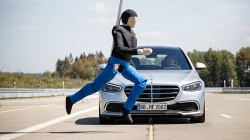Some of the new products on show
VRU testing for ADAS and AV
Messring
 Pedestrians, cyclists and drivers of motorized two-wheelers – commonly referred to vulnerable road users (VRUs) – are among the most at-risk traffic participants. Advanced driver assistance systems (ADAS) as well as autonomous driving and safety systems have the potential to make these individuals significantly safer.
Pedestrians, cyclists and drivers of motorized two-wheelers – commonly referred to vulnerable road users (VRUs) – are among the most at-risk traffic participants. Advanced driver assistance systems (ADAS) as well as autonomous driving and safety systems have the potential to make these individuals significantly safer.
Numerous software and hardware test cycles are run during the development of these systems, requiring validation during the process by real-life test scenarios on proving grounds. Only the testing of all components in an integrated system can guarantee a reliable conclusion about the functionality before the vehicles can proceed to serial production.
The challenge for the test procedures is to realistically reproduce traffic situations, especially critical boundary cases, and thus to test the intervention, prevention or mitigation of critical collisions between vehicle and VRU in a reproducible way under real conditions with VRU dummies on the test site.
The scenario complexity and heterogeneity of the VRUs must be represented with matching test tools and VRU dummies, to effectively carry out the testing operations.
For the different types of road users in different scenarios, it is necessary to have mobile targets that mimic a real person in terms of sensor signature while being easy to use and rugged enough to survive collisions without damage. These validated, realistic testing tools help vehicle developers recreate reality in all its diversity on the proving ground and help to ensure safety on the road.
Messring’s Active Safety Test Robot, or ASTERO, is a robust target designed for the validation of autonomous vehicle sensors and software with a focus on pedestrian emergency brake systems. It mimics the motions of real pedestrians, with the feet touching the ground and realistically moving joints operated through pneumatic muscles. It also shows the same degree of radar reflectivity as a human. The ASTERO can be programmed with the real motion data from a motion detection system and enables accurate validation of sensor systems and associated pedestrian detection software.
With its ASTERA E-Scooter, Messring has developed a VRU target that is suitable for numerous test scenarios. It realistically replicates a woman on an e-scooter in terms of shape as well as radar, lidar, camera and infrared signature.
Messring’s VRU portfolio is completed by the Playing Child Target (PCT), which is designed to mimic a child on a toy car. It is suitable for performing AEB tests, especially AEB VRU pedestrian back-over tests. For an additional challenge, all targets are also available with a low-contrast black and gray outer cover.
Booth: 1038
